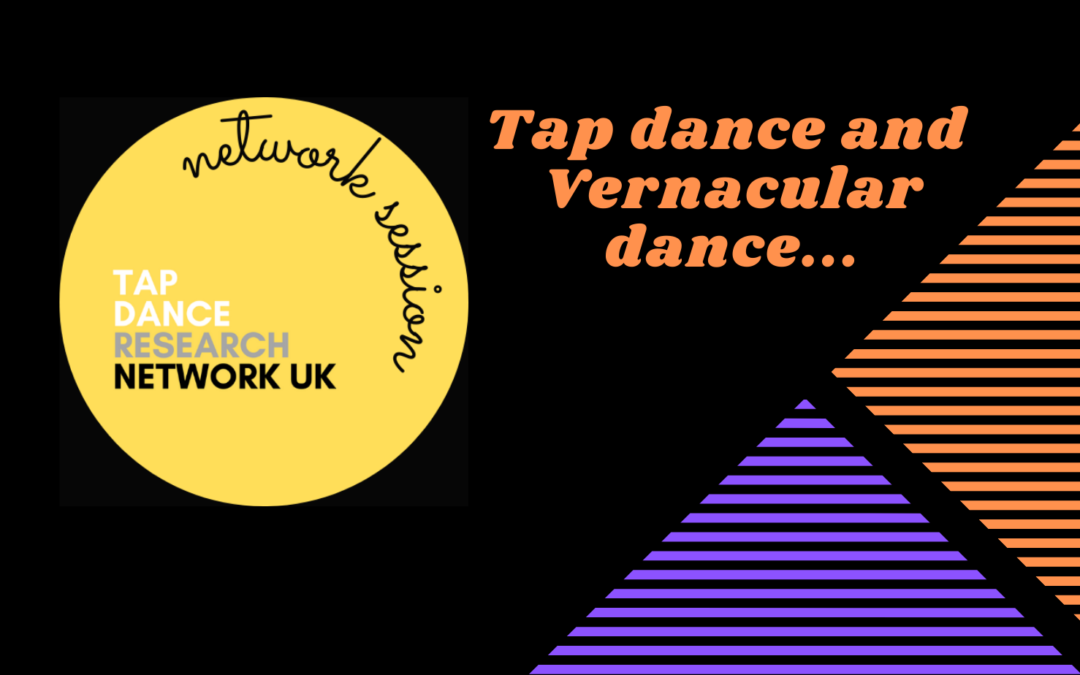Following our session about tap dance and vernacular dance, this session explored what the benefits and challenges are of viewing tap dance from the perspective of ‘vernacular dance’.
We discussed the way in which scholars define ‘vernacular’ differently, focussing on different aspects depending on their area of interest. Some examples of this include:
“In describing the black vernacular tradition, which has been crucial to the story of American social dance, dance scholar Jacqui Malone sees it as “an evolving tradition and a vital process of cultural production”. She quotes Ralph Ellison…He refers to it as “a dynamic process in which the most refined styles from the past are continually merged with the play-it-by-eye-and-ear improvisations” (Malnig 2009, 4).
“Popular dance is also identified according to a specific process by which local, vernacular, and social dance traditions become popularized in the public sphere” (Malnig 2009, 5).
“In social dancing, a sense of community often derives less from preexisting groups brought together by shared social and cultural interests than from a community created as a result of the dancing” (Malnig 2009, 4).
“Crease (2000, p. 110) is consistent in his use of the term ‘vernacular dance’ which he describes as ‘the kind in which people dance amongst themselves, spontaneously, without professional training, in ordinary spaces without sharp borders between participants and spectators” (Dodds 2011, 47).
The Stearns define vernacular as “in the sense of native and homegrown” (Stearns and Stearns 1979, xvi).
“It’s hallmarks are improvisation and spontaneity, propulsive rhythm, call-and-response patterns, self-expression, elegance, and control” (Malone 1996, 2).
In groups we went on to consider our own descriptions of what vernacular dance is by contrast and comparison with ‘social dance’ and ‘popular dance’ by thinking about what is the dance like? Who dances? Why do they dance? How, the and where does the dance happen? How is the dance accessed by those who do it and those who witness it?
This discussion highlighted some key issues such as:
Who gets to decide what is ‘vernacular’, ‘popular’ and ‘social’ dance and what is the motivation for naming dance practices in this way? Is this empowering or disempowering for those that doing the dance, especially if they are doing so on a professional basis?
What are the processes by which a dance form moves from being considered ‘vernacular’ to be understood as something else such as ‘popular’, ‘commercial’ or event professional art practice?
These issues are echoed in further quotes from scholars:
“We need to do away with the labels that separate popular and so-called art culture. In the case of the Lindy and so-called modern dance, these labels serve the function of racism by separating the realms of endeavor that have traditionally been reserved for blacks— that is, vernacular or pop culture— from those that are the exclusive property of whites— namely, the world of ‘art’” (Gottschild, 2000 P215).
Dodds references dance scholar Theresa Buckland’s definition of popular dance as a “fashionable dance form: can be associated with popular music recordings. Tends to be transmitted through fashionable centres for dancing, including schools of dance, or nowadays through television. Tendency to innovation (Buckland 1983, 326)’. This brief description is part of a triadic paradigm in which the popular is set in contrast to an extended consideration of a ‘classical’ and ‘folk’ dance bianary; hence ‘the popular’ is both marginalized and defined through what it is not” (Dodds 2011, 47).
“In jazz dance, too often that missing link is African-American vernacular dance. Acknowledging the entirety of the genre allows us to establish historical, cultural, social, and kinetic continuity, which I call a continuum” (Cohen in Oliver & Guarino, 2014 P.3).
“I firmly hold to the view that pop music is not the future for jazz dance. It is important that jazz dance not limit itself to commercial trends and instead embrace its ability to generate new modes of movement invention through play and improvisation” (Wray in Oliver & Guarino, 2014 P.15).
“In black vernacular dancing, improvisation means the creative structuring, or the choreographing, of human movement in the moment of ritual performance” (Jackson 2001, 44).
“Black vernacular dance aesthetics force us to rethink dualistic Platonic- Cartesian notions and the sometimes ethnocentric divisions between improvisation and so- called set choreography” (Jackson 2001, 49).
Following this discussion, we broke into smaller groups to discuss how this topic relates to key areas of our tap dance practice; teaching, musicianship and industry contexts.
Teaching and working in educational settings – This group discussed how history, culture and musicality specific learning is largely missing in dance studio practice. The group identified a need for this to be better integrated into environments where competitions and syllabus are often the dominant approach. The group also explored the need to allow tradition to sit alongside innovation in teaching and creative work with learners.
Musicianship – This group discussed different aspects of musicianship available to tap dancers such as the tonality of the taps, and the musical role of tap dance when combined with other instruments.
Industry contexts – This group discussed the difficulties experienced by tap dance artists navigating funding and arts institutions that frame dance and music as separate disciplines. Resistance by industry ‘gatekeepers’ to accepting tap dance as being simultaneously dance, music and theatre led the group to consider the possible need to re-label tap dance in a way that reflects its roots in Africanist aesthetics.
Resources:
Dodds, S. (2011) Dancing on the Canon: Embodiments of Value in Popular Dance. Basingstoke: Palgrave Macmillan.
Gottschild, B, D. (2000) Waltzing In The Dark : African American Vaudeville and Race Politics in the Swing Era, Palgrave Macmillan,
Jackson, J “Improvisation in African-American Vernacular Dancing” Dance Research Journal, Winter, 2001, Vol. 33, No. 2, Social and Popular Dance (Winter, 2001), pp. 40-53 Published by: Congress on Research in Dance
Malnig, J. (ed.) (2009) Ballroom, Boogie, Shimmy Sham, Shake: A Social and Popular Dance Reader. Chicago: University of Illinois Press.
Malone, J. (1996) Steppin on the Blues: The Visible Rhythms of African American Dance. Chicago: The University of Illinois Press.
Stearns, M. and Stearns, J. (1968) Jazz Dance: The Story of American Vernacular Dance. New York: Da Capo.
Wells, C. (2021) Between Beats: The Jazz Tradition and Black Vernacular Dance. New York: Oxford University Press.
Wray, S. “A Twenty-First-Centry Jazz Dance Manifesto” Oliver, W & Guarino, L (2014) Jazz dance: a history of the roots and branches. Gainesville, Florida: University Press of Florida.

